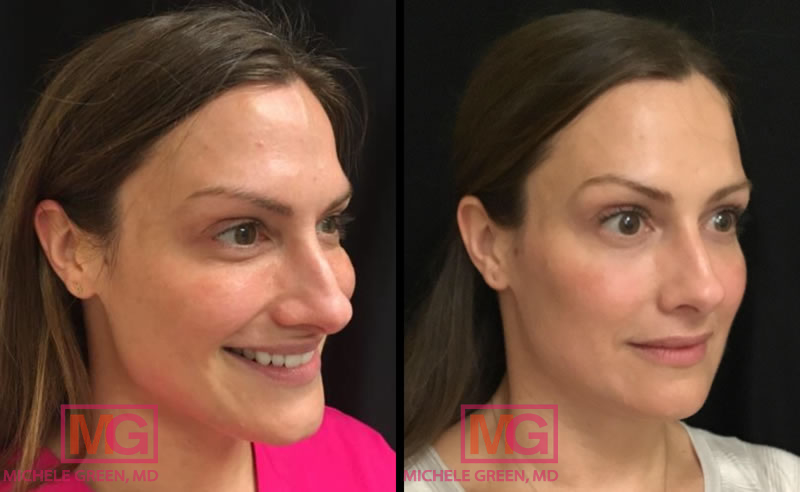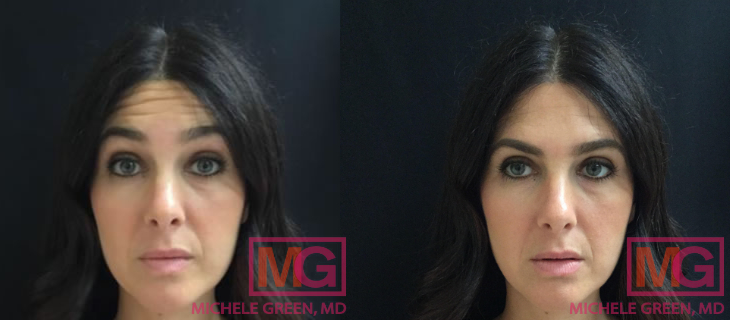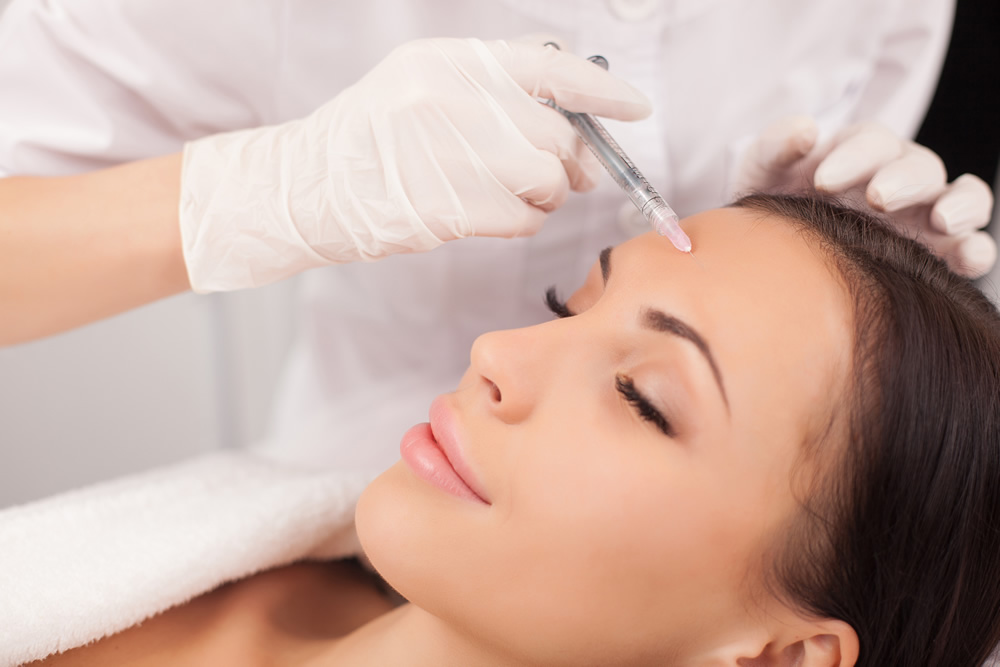Botox vs Juvederm
In the world of cosmetic dermatology, dermal fillers and injectables have become one of the most popular ways to reduce the signs of aging, from fine lines and wrinkles to age-related volume loss. When considering a dermal filler or injectable treatment, many patients wonder, which one is right for me?
Botox and Juvederm are two of the most popular non-invasive injectables in cosmetic treatment today. Both are created by the same parent company, Allergan, but they have very different mechanisms of action and approaches to reducing the visible signs of aging.
If you’re wondering which dermal filler or injectable cosmetic treatment is best for you, board-certified NYC dermatologist, Dr. Michele Green, is here to help. Dr. Green is an expert in minimally invasive anti-aging procedures, skin care, and laser skin treatments. Contact the New York office today to develop a customized skin rejuvenation treatment plan designed exclusively for you.
What is the difference between Botox and Juvederm?
Both Botox and Juvederm are considered non-invasive injectables, meaning that they improve the look and feel of your skin without the need for invasive surgery or downtime. They are both excellent alternatives to invasive cosmetic procedures or plastic surgery options, such as a facelift or permanent implant procedure, as the results are temporary and the procedure is fast and easy.
Though Botox and Juvederm are both designed to reduce the appearance of facial wrinkles and fine lines in a variety of areas of the face, the ways in which they operate are quite different.
Botox, the most well-known brand name in dermal fillers, is a neurotoxin derived from botulinum toxin that halts signals to nerve endings at or near the injection site. This process essentially “freezes” facial muscles so that wrinkles and folds are stopped in their tracks. For this reason, Botox treatment is a popular choice for reducing the appearance of dynamic wrinkles, a type of wrinkle that is created from repeated use of certain muscles. There are many used for Botox cosmetic such as treating the glabella (furrows between the eyebrows), forehead wrinkles, neck wrinkles, Crow’s feet (eye wrinkles), and for facial slimming (in the masseter area) Botox also has a variety of medical uses as well, including for those experiencing hyperhidrosis (excessive sweating), TMJ, and chronic migraines.
Juvederm, on the other hand, is a hyaluronic acid filler. Juvederm injectables use hyaluronic acid, a substance naturally found in the body, to stimulate collagen and elastin production at or near the injection site. Juvederm has a variety of different specific formulations that are designed to target different types of wrinkles, from smile lines and marionette lines to volume loss in the midface and the lips. The Juvederm family of fillers includes Juvederm Vollure, Juvederm Ultra Plus XC, Juvederm Voluma XC, and Juvederm Volbella. The choice of Juvederm dermal filler depends on the anatomic area of the face, thickness of the product desired, and longevity needed.

Female treated with 1 syringe of Juvederm Voluma
Is Juvederm the same as Botox?
So, is Juvederm Botox? Definitely not! As Juvederm is a hyaluronic acid filler, its means of reducing the appearance of aging are completely different. Juvederm, like other dermal fillers, essentially “fills in” wrinkles as a way to reduce the appearance of mild to severe wrinkles and folds on the face. Its formulation also allows it to add volume to different areas of the face, which corrects the age-related volume loss that many patients experience in their middle-age.
Botox injections have a different anti-aging approach. As the active neurotoxin, botulinum toxin type A, is able to interrupt nerve signals to muscle groups, Botox is able to reduce the appearance of aging from the inside out, reducing facial wrinkles that are caused by repetitive facial expressions, such as crow’s feet, frown lines, and forehead wrinkles.
Is Juvederm safer than Botox?
Both Juvederm and Botox are FDA-approved for reducing the appearance of fine lines, wrinkles and folds on the face, and are incredibly safe and effective when administered by an experienced medical professional. Botox is also approved in the United States for several medical uses.
However, there can be risk to both procedures when an inexperienced injector is responsible for treatment. Medical spas or “Botox parties” have become a popular source for cosmetic injectables, offering free consultations and discounted prices for treatment. These environments often administer treatment without the close oversight of a medical professional, which can lead to severe side effects to both Juvederm and Botox, including allergic reaction, vision impairment, paralysis, and toxicity.
For this reason, we recommend that you only receive Juvederm and Botox injectables from an experienced, board-certified plastic surgeon or dermatologist, such as Dr. Michele Green in NYC. Only an expert medical professional can provide you with the safety and excellent care that you deserve.
Which is better, Botox or Juvederm?
Due to their distinctive anti-aging properties, Botox and Juvederm are each tailored to best treat different types of wrinkles and signs of aging.
Botox is excellent for treating dynamic wrinkles, such as crow’s feet, frown lines, and forehead wrinkles. Juvederm is an excellent choice to reduce wrinkles through volume correction, and can help to limit the appearance of volume loss in the cheek areas, under the eyes, and in the lips. It’s also an excellent choice to reduce the appearance of deeper facial wrinkles and folds, including the nasolabial folds (commonly known as “smile lines”), and marionette lines (lines under the lips along the chin), and perioral lines (also known as vertical lip lines or “lipstick lines”) and lip augmentation.
Using Juvederm Voluma with Botox for various treatments
In addition to cheek fillers, Juvederm Voluma with Botox are two different types of treatments that can be used together successfully to treat fine lines, general mid-face sagging and wrinkles in the face. Botox is also great at treating areas from the eyes upwards on the face, as well as the neck, whereas dermal fillers can complement this treatment since they are great at targeting areas from the eyes downward. When Juvederm Voluma is combined with Botox, it can help provide a more youthful appearance.
The length of time that Botox can be effective for is typically around three to four months before the treatment needs to be repeated. Juvederm Voluma on the other hand is a procedure that lasts much longer. Generally, results are effective for between twelve months and in some cases, up to eighteen months.
Can Botox and Juvederm be used together?
For optimal facial rejuvenation, Botox and Juvederm are often combined to target both dynamic and static wrinkles, from mild to severe wrinkles and folds. Each can target different areas of the face in order to reverse and prevent signs of aging, depending on when treatment begins.
What else should you know about Juvederm?
Juvederm is a non-invasive cosmetic procedure that uses hyaluronic acid to natural kick-start collagen and elastin production in the body. It’s an excellent way to reduce the appearance of fine lines and wrinkles through the restoration of youthful volume. Juvederm is temporary but durable, with results lasting between 6 months to over a year depending on the particular formulation and treatment area.
Juvederm is a family of hyaluronic acid products, with different tailored compositions:
- Juvederm Volbella XC, Juvederm Ultra XC, and Juvederm Ultra Plus XC for lip augmentation and correction of perioral lines
- Juvederm Vollure XC and Juvederm XC for mild to severe facial wrinkles and folds
- Juvederm Voluma XC for volume-loss correction in the midface.
Juvederm is also unique in that the treatment is entirely reversible, through the use of synthetic hyaluronidase. Hyaluronidase is what metabolizes hyaluronic acid naturally in the body, and can be injected to reverse any unwanted results from hyaluronic acid fillers.
Does Juvederm hurt more than Botox?
Juvederm and Botox are both injectables, meaning that you may experience mild discomfort when the fine needle is injected into the skin. Some patients experience more discomfort with Juvederm injections as the injectable gel does have a bit more density in its composition. However, this potential discomfort is prevented through the use of topical numbing cream, and the inclusion of lidocaine (anesthetic) in all Juvederm XC fillers.

Female treated with Botox on Glabella and Eye Area
How does Botox work?
Botox treatment uses the effects of a common neurotoxin, botulinum toxin type A (the same toxin responsible for botulism), to target particular nerve signals. By interrupting these nerve signals, Botox is able to temporarily halt the use of certain muscles that cause wrinkles when overused in facial expressions. When Botox is injected by an experienced injector like Dr. Green, the Botox injections are able to “freeze” unnecessary muscle use that cause facial wrinkles, reducing the appearance of dynamic wrinkles without limiting common facial expressions.
Can I wear makeup after Botox and Juvederm?
When you arrive for your appointment for Juvederm or Botox treatment, its best to come with a fresh, clean face without makeup. After the procedure, you can go about normal daily activities as you normally would, but we do recommend you avoid intensive heat exposure (saunas, hot tubs) and extreme exercise. Just a few hours after treatment, you will be able to wear makeup as you normally would on the treated area, and to remove any makeup or sunscreen with a gentle cleanser.
Which areas do neurotoxins like Botox, Dysport, Xeomin, Revance, and Jeuveau treat?
Neurotoxins including Botox, Dyspot, Xeomin, Revance, and Jeuveau are all used to treat dynamic wrinkles, which are lines caused by the repeated motion of certain muscles involved in facial expressions. They all have slightly different formulations, but each used the active ingredient of botulinum toxin in order to halt nerve signals to these wrinkle-causing muscle groups.
How do you know which injectable is right for you?
When it comes to injectables, it all depends on the particular needs and aesthetic goals of the patient. If you are interested in reducing the appearance of dynamic wrinkles, it could be that Botox is best for you. If you’re struggling with volume loss in the midface or the lips, or are dealing with deep folds around the lips and chin, dermal fillers such as Juvederm, Restylane, Radiesse and Belotero may be the right choice. If you’re interested in reducing the appearance of fat deposits along the jawline and chin, it could be that Kybella is right for you.
Whatever your current facial wrinkles or desired look, Dr. Green is here to develop the best skincare and treatment protocol for you. Dr. Green has been working with injectables and dermal fillers for over 25 years in her New York dermatology office, and has both the knowledge and artistry necessary to determine a custom injectable treatment plan that will give you the best cosmetic results.

What is the difference in dermal fillers?
Different dermal fillers have different composition and formulation. Juvederm, Restylane, Sculptra, Radiesse, and Belotero are all hyaluronic acid fillers, which help to stimulate collagen and elastin production in the body. Radiesse is a calcium filler that targets naturally-occurring collagen growth at or near the injection site. Sculptra is a proprietary formulation of poly-L-lactic acid, which estimates your skin’s own natural collagen production. Each has their own different durability and targeted areas of the face when it comes to treatment.
What do dermal fillers correct?
Dermal fillers correct natural, age-related volume loss, or a lack of natural volume in different areas of the face. They essentially reduce the appearance of wrinkles, folds, and skin laxity by “boosting” the volume of the skin and “filling in” the space that the fold creates. They can also boost volume in the under-eye area, cheek area, and lips.
What are the side effects of Botox and dermal fillers?
Common side effects of injectables include swelling, redness, bruising, bumps, or itching at or near the injection side. Typically, these side effects will dissipate over the course of a few days post-treatment, and are generally mild.

What is the difference between Restylane and Juvederm?
Restylane and Juvederm are the brand names for two different hyaluronic acid filler families. Each has several customized hyaluronic acid fillers, designed to target different areas of the face and types of wrinkles. Restylane generally has a slightly lower price-point per unit, as well as slightly lower durability than its Juvederm counterpart. Both dermal filler lines are excellent at correcting a variety of fine lines, wrinkles and folds, as well as at correcting volume on the midface and lips. Restylane Lyft can be used on the mid-face, similar to Juvederm Voluma, and also recently received FDA approval to reduce the appearance of aging on hands.
Why choose Dr. Green as your injector for Botox or Juvederm injections?
When it comes to maximizing the best cosmetic results for dermal fillers and injectables, there is no better injector than Dr. Green. Dr. Green’s expansive understanding and practice with both Botox and Juvederm allow her to approach each individual with a custom-tailored treatment plan that will lead to a natural, optimal result. As a board-certified dermatologist, Dr. Green’s first priority is always the safety and satisfaction of her patients, and she will use her gentle artistry to ensure that you both look and feel like the best possible version of yourself.
Dr. Michele Green is a board-certified dermatologist based in NYC and an expert in a wide variety of cosmetic treatments including Botox and Juvederm Voluma. Find out more and contact us online or at 212 535 3088 to arrange an appointment.
 212-535-3088
212-535-3088